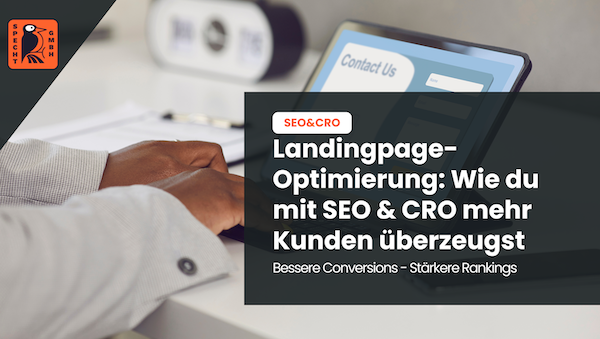In a nutshell: What is a meta title?
The meta title (also: meta title; title tag) is an element in the HTML code that defines the title of a web page. In the search results, this title is listed above the meta description and is an essential ranking factor for search engines such as Google and Bing.
What role does the meta title play in search engine optimization?
The meta title is an integral part of search engine optimization(SEO). By assigning a meta title to each subpage on their entire website, website operators make it easier for search engines to get an impression of the content of the page. This allows the search engine algorithms to better assess the relevance of the content, which has a positive impact on the ranking of the page in the search results.
If website operators do not assign the page title or other metadata themselves, the search engine's algorithm generates the meta elements itself - this usually results in an unnatural and truncated meta title that does not accurately describe the content of the page. As a result, the missing page titles significantly worsen the ranking of a website.
Apart from the search engine algorithms, users also expect a title that aptly covers their search intention. If website operators succeed in formulating a page title that sparks users' curiosity right away, the probability of a high click rate is given. Rising click rates encourage an increasing number of website visitors and promote the achievement of individual goals with the website - whether the goal is to increase sales figures in the online store, generate leads for insurance companies or increase the number of readers on your own blog.
-
Free
SEO strategy meeting
In a free SEO strategy talk, we uncover untapped potential and develop a strategy to help you become more successful on Google.

- More organic visibility
- More organic visitors to your website
- More inquiries & sales
What is the best way to write the meta title?
Keyword focus. Brevity. Conciseness. - This summarizes the three most important characteristics of good page titles. In addition to these quality features, the technically correct implementation of the meta title must be taken into account. As part of the HTML code, the meta title can be found in the header area of every web page. The implementation of the meta title in the code is done as follows:
<head>
<title>“Title Tag“</title>
[Weitere Inhalte…]
</head>
Most content management systems (CMS) contain predefined fields for the meta information (meta title and meta description), so that operators are spared having to intervene in the HTML code for their website. According to the core criteria of keyword focus, brevity and conciseness, Meta Title and Meta Description are entered into the designated fields and simply confirmed.
Meta title with focus on the most important keyword
In online marketing and search engine optimization, the principle has proven itself that a maximum of one main keyword or keyword combination should be focused on per website. If the main keyword is "motorcycle helmet" or the keyword combination is "red suit socks", then exactly this main keyword or keyword combination should appear in the meta title.
The premise is that the main keyword or keyword combination is written as far as possible at the beginning of the meta title. In this way, the users and the algorithm of each search engine are directly suggested the keyword relevance - this has a positive effect on the flow of visitors to the website and on the ranking of the respective website.
Equally important for meta title and meta description: brevity and conciseness
Brevity as a core criterion for good meta titles and meta descriptions is derived from two reasons. On the one hand, the restrictions imposed by search engines and, on the other, the tendency of users to have a short attention span speak in favor of short meta elements. For further explanation:
- Numerous search engines such as Google limit the length of the meta title to a maximum pixel width of 580 pixels for technical and practical reasons.
- This corresponds to a maximum number of characters of the meta title of 70 characters - including the blank lines.
- For safety, a meta title of 55 to 65 characters is recommended. Everything beyond the pixel width of 580 pixels will be truncated by search engines.
- The snippet generator of Sistrix helps to keep the maximum length of meta titles and meta descriptions.
Apart from this aspect of SEO, a short meta title has the advantage that the usually short attention span of users is utilized efficiently: In times when users scroll down the search results and only skim the titles when searching, those website operators who write a compact and concise meta title usually have an advantage. Website operators need to be creative in order to formulate the meta title concisely: Call-to-actions, provocative statements, lurid announcements and other stylistic devices can be used to increase the probability of clicks by users.
Although the guidelines just described primarily concern the title tag, they can also be applied to the meta description. Meta title and meta description are always displayed together in the search results. Even though the meta title is displayed in a larger size, catches the eye of users directly and, unlike the meta description, is important for SEO, the meta description is also important. It provides more details about the content of the page and helps users to decide whether to visit the page or not.
Google provides further valuable tips on the title tag and its implementation in its Google Search Central.
- I am one of the leading SEO experts in Germany
I am known from big media such as Stern, GoDaddy, Onpulson & breakfast television and have already worked with over 100+ well-known clients successful on Google.
Google rating
Based on 185 reviews
Trustpilot rating
Based on 100 reviews
Good to know: the meta title is not part of the meta tags
Although it has become common usage, the title tag is strictly speaking not a meta tag and not part of the meta information. For reasons of simplicity and due to the formerly great SEO relevance of the meta tags, it is nevertheless assigned to the metadata.
Correctly considered, the Meta Title is the title of the HTML document and thus the title of the web page. It is different with the metadata, which has only descriptive functions and provides more detailed info about the content and the correct presentation of the content of the page. Although the metadata is also read by the search engine, this now serves purely informative purposes. The Meta Title, on the other hand, has not lost a bit of ranking importance for SEO compared to the past - unlike the metadata.
Conclusion: What is a meta title?
The Meta Title, unlike the Meta Description, has a high SEO relevance. It should be created for each page of the entire website, following the qualitative principles of keyword focus, brevity (ideally 55-65 characters) and conciseness. With a good Meta Title, bloggers, businesses, store owners and other website owners attract more visitors to their website. This results in increasing popularity of the website and faster achievement of individual goals.






